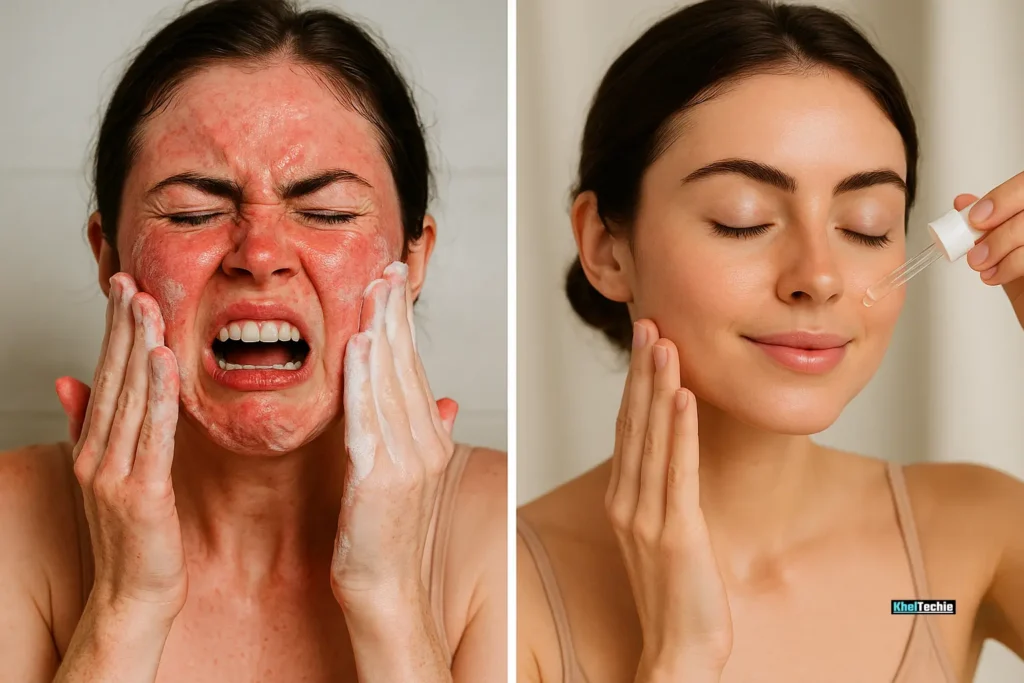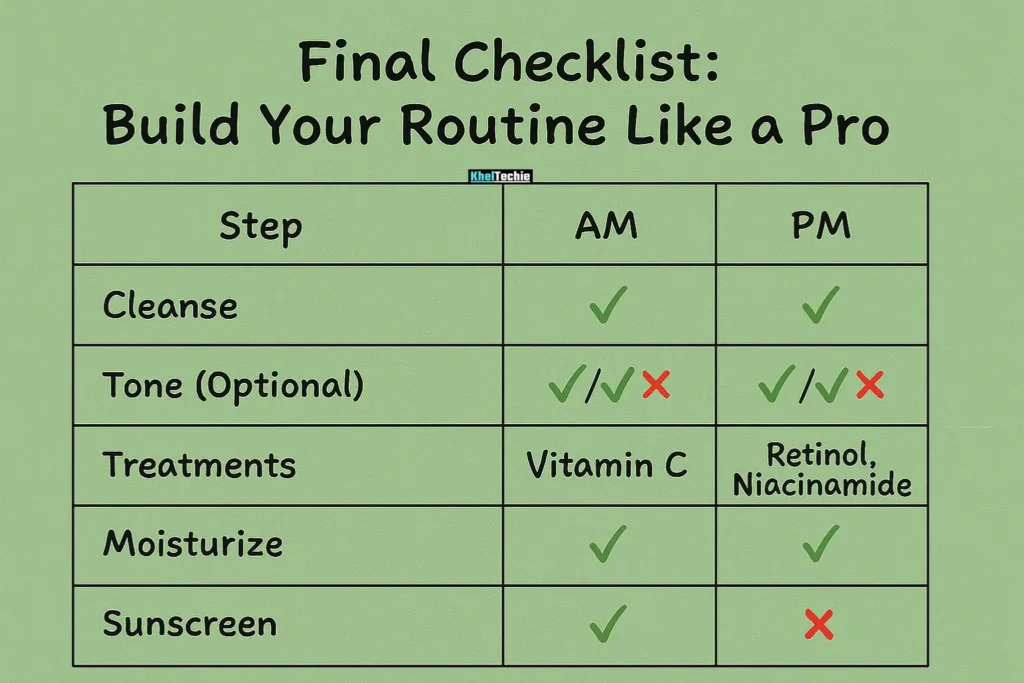How to Build a Healthy Skincare Routine in 6 Simple Steps
Sick of Skincare Guesswork?
Ever stood in front of your mirror, staring at a shelf full of bottles, unsure where to start? You’re not alone.
Building a healthy skincare routine can feel overwhelming, especially with so many products promising miracles but delivering mixed results. The truth is, a good skincare routine isn’t about buying the most expensive serum or chasing TikTok trends. It’s about understanding your skin and giving it exactly what it needs, no more & no less.
In this article, we’ll walk you through how to build a healthy skincare routine tailored to your unique skin type and lifestyle. No fluff, just clear, science-backed steps that actually work.
Let’s get started.
Also read – Top 10 Micro-Habits for Daily Wellness Success

What is a Healthy Skincare Routine?
Think of your skin like a garden. You wouldn’t water all plants the same way, would you? Similarly, building a healthy skincare routine means customizing your care based on your skin’s needs, whether it’s dry, oily, combination, sensitive or acne-prone.
At its core, a healthy skincare routine includes:
- Cleansing to remove dirt and oil
- Toning to balance pH levels
- Treating with targeted serums or actives
- Moisturizing to hydrate and protect
- Sunscreen during the day to prevent damage
But here’s the catch, not everyone needs all five steps every day. That’s where personalization comes in and that’s what makes a routine truly healthy.

Why Building a Healthy Skincare Routine Matters
Building a healthy skincare routine is about more than chasing glowing skin, it’s a simple act of self-care that delivers mental, emotional and physical benefits. Think of it this way, every evening, as you cleanse and treat your skin, you’re giving it the nutrients it needs to repair and regenerate while you sleep And that matters. Research in Teen Vogue (June 2025) shows that during deep sleep, your skin becomes more receptive to active ingredients like retinol and peptides, while poor sleep can trigger inflamed, stressed-out skin thanks to elevated cortisol .
But skincare isn’t just skin-deep. A landmark Unilever study (May 2025), conducted with the University of Liverpool, discovered that certain Cutibacterium strains naturally occurring on your skin are linked to lower stress and improved mood. So your daily cleansing, moisturizing and protecting routine isn’t just making your complexion clear, it’s supporting your mental wellbeing too.
In short, your skincare routine is a powerful investment, you’re helping your skin heal and shine while also nurturing your overall health. It’s not superficial, it’s holistic self-care at its best.

How to Build a Healthy Skincare Routine
Let’s break it down into simple, actionable steps.
Step 1: Identify Your Skin Type
Before choosing any product, know your skin type:
| Skin Type | Characteristics |
|---|---|
| Normal | Balanced, few imperfections |
| Dry | Tight, flaky, sometimes itchy |
| Oily | Shiny, enlarged pores, frequent breakouts |
| Combination | Oily T-zone, dry cheeks |
| Sensitive | Redness, irritation, easily reactive |
Wash your face, wait 30 minutes without applying anything, then observe how your skin feels.
Step 2: Determine Your Skin Concerns
Are you dealing with:
- Acne or breakouts?
- Dark spots or hyperpigmentation?
- Fine lines and wrinkles?
- Redness or sensitivity?
- Dullness or uneven texture?
This will help you pick the right active ingredients (like retinol, vitamin C or hyaluronic acid).
Step 3: Start with the Basics (The Holy Trinity)
1. Cleanser
Choose one that matches your skin type:
- Oily skin: Gel-based or foaming
- Dry skin: Cream or balm
- Sensitive skin: Fragrance-free, gentle formula
Use twice a day, once in the morning and once at night.
2. Moisturizer
Even oily skin needs hydration! Look for:
- Lightweight formulas for oily skin (gel or water-based)
- Rich creams for dry skin
- Non-comedogenic options to avoid clogging pores
Apply after cleansing and treatment steps.
3. Sunscreen (AM Only)
Use a broad-spectrum SPF 30+ every single day, yes, even when it’s cloudy.
Recommended types:
- Chemical SPF: Absorbs UV rays (e.g., Neutrogena Ultra Sheer)
- Physical SPF: Reflects UV rays (e.g., EltaMD UV Clear)
Step 4: Add Treatment Products Based on Needs
These go between cleansing and moisturizing.
| Skin Concern | Recommended Ingredients |
|---|---|
| Acne | Salicylic acid, benzoyl peroxide |
| Hyperpigmentation | Vitamin C, niacinamide |
| Aging | Retinol, peptides |
| Dryness | Hyaluronic acid, ceramides |
| Sensitivity | Centella asiatica, oat extract |
⚠️ Always patch test new actives and introduce them gradually.
Step 5: Know When to Layer and How
Here’s a simple rule to follow:
Morning Routine:
- Cleanser
- Toner (optional)
- Antioxidant Serum (e.g., Vitamin C)
- Eye Cream
- Moisturizer
- Sunscreen
Night Routine:
- Cleanser
- Toner (optional)
- Treatment Serums (e.g., Retinol, Niacinamide)
- Eye Cream
- Moisturizer
Double Cleansing Tip: If you wear makeup or sunscreen, start with an oil-based cleanser followed by a water-based one.
Step 6: Don’t Forget About Lifestyle Habits
Skincare doesn’t stop at topical products. What you eat, drink and do affects your skin too.
✅ Drink enough water
✅ Eat antioxidant-rich foods (berries, leafy greens)
✅ Get 7–9 hours of sleep
✅ Manage stress (try meditation or yoga)
✅ Avoid smoking and excessive alcohol

Common Mistakes to Avoid
Even dermatologists cringe at these skincare blunders:
1. Skipping Sunscreen
We’ve said it before and we’ll say it again that sunscreen is non-negotiable. UV rays cause 80% of visible facial aging.^[3]^
2. Over-Exfoliating
Using scrubs or acids every day strips your skin barrier. Stick to 1–2 times a week max.
3. Using Too Many Actives at Once
Layering retinol + glycolic acid + vitamin C = irritated skin. Introduce one at a time.
4. Not Patch Testing New Products
Always test on a small area (like behind your ear) before slathering it on your face.
5. Buying Based on Trends
Just because it’s viral doesn’t mean it’s right for your skin. Focus on what works for you.

✅ Final Checklist: Build Your Routine Like a Pro
| Step | AM | PM |
|---|---|---|
| Cleanse | ✅ | ✅ |
| Tone (Optional) | ✅/❌ | ✅/❌ |
| Treatments | Vitamin C | Retinol, Niacinamide |
| Moisturize | ✅ | ✅ |
| Sunscreen | ✅ | ❌ |
Also read – How to Create a Sleep Sanctuary at Home

Conclusion: Ready to Build Your Healthy Skincare Routine?
Building a healthy skincare routine doesn’t mean following trends or buying $300 serums. It means understanding your skin, using the right ingredients and showing up daily. Whether you’re 18 or 58, it’s never too early or too late to invest in your skin’s future.
If this guide helped you, share it with a friend who might benefit And don’t forget to leave a comment below & tell us about your favorite skincare product or ask a question. We’d love to hear from you!
This guide is for general info only. Always patch-test new products and talk to a dermatologist if you have sensitive skin or medical concerns. What works for others may not work for you.
FAQs: Answering All Your Burning Questions
How Often Should I Cleanse My Face?
Twice a day, once in the morning and once at night. Over-cleansing can strip natural oils.
Do I Need a Toner?
Not mandatory, but toners can help prep your skin for better absorption of treatments. Great for oily or congested skin.
Can I Skip Moisturizer If I Have Oily Skin?
Nope! Skipping moisturizer can make your skin produce more oil to compensate. Use a lightweight, oil-free option.
Should I Double Cleanse Every Night?
Only if you wear makeup, sunscreen or heavy products. Otherwise, a regular cleanser is enough.
How Long Before I See Results?
Give each product minimum of 8 weeks to work. Skin cell turnover takes time!
Is It Safe to Use Retinol During the Day?
Retinol breaks down in sunlight and can increase sensitivity. Always use it at night and pair with sunscreen in the AM.
Can I Use Vitamin C in the Evening?
Yes! While it’s typically used in the morning for antioxidant protection, it still works at night. Just store it properly (cool, dark place).
What Ingredients Should I Avoid Mixing?
Avoid mixing:
Retinol + AHAs/BHAs (can cause irritation)
Vitamin C + Niacinamide (may reduce effectiveness unless formulated together)
Benzoyl Peroxide + Retinoids (can cancel each other out)
How Do I Know If a Product Works?
Look for improvements in texture, tone, clarity and hydration over time. If you experience redness, burning or breakouts, discontinue use.
How Can I Save Money on Skincare?
Stick to the basics first. You don’t need 10 serums. Also, check drugstore brands like CeraVe, The Ordinary and Paula’s Choice, they offer high-quality, affordable options.




